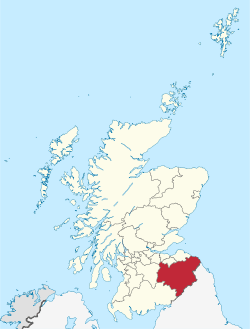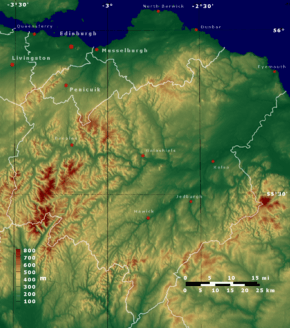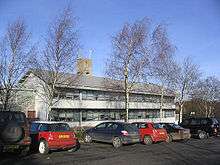Scottish Borders
| Scottish Borders The Mairches | ||
|---|---|---|
 | ||
| ||
| Coordinates: 55°21′36″N 2°29′24″W / 55.36000°N 2.49000°WCoordinates: 55°21′36″N 2°29′24″W / 55.36000°N 2.49000°W | ||
| Admin HQ | Newtown St Boswells | |
| Government | ||
| • Body | Scottish Borders Council | |
| • Control | SNP + Ind + LD (council NOC) | |
| • MPs |
| |
| • MSPs |
| |
| Area | ||
| • Total | 1,831.15 sq mi (4,742.65 km2) | |
| Area rank | Ranked 6th | |
| Population (2010 est.) | ||
| • Total | 114,000 | |
| • Rank | Ranked 17th | |
| • Density | 60/sq mi (24/km2) | |
| ONS code | 00QE | |
| ISO 3166 code | GB-SCB | |
| Website |
www | |

The Scottish Borders (Scots: The Mairches) is one of 32 council areas of Scotland.[1] It borders the City of Edinburgh, Dumfries and Galloway, East Lothian, Midlothian, South Lanarkshire, West Lothian and, to the south and east, Northumberland in England. The administrative centre of the area is Newtown St. Boswells.
Historically, the name Scottish Borders designated the entire border region of southern Scotland and, together with neighbouring areas of England, was part of the historical Borders region.
Geography
The Scottish Borders are in the eastern part of the Southern Uplands.[2]
The region is hilly and largely rural, with the River Tweed flowing west to east through it. In the east of the region, the area that borders the River Tweed is flat and is known as 'The Merse'.[3] The Tweed and its tributaries drain the entire region with the river flowing into the North Sea at Berwick-upon-Tweed, and forming the border with England for the last twenty miles or so of its length.
The term Central Borders refers to the area in which the majority of the main towns of Galashiels, Selkirk, Hawick, Jedburgh, Earlston, Kelso, Newtown St. Boswells, St Boswells, Peebles, Melrose and Tweedbank are located.
Largest towns
2011[4]
- Galashiels: 14,994
- Hawick: 14,294
- Peebles: 8,376
- Selkirk: 5,784
- Kelso: 5,639
- Jedburgh: 4,030
- Eyemouth: 3,546
- Innerleithen: 3,031
- Duns: 2,753
- Melrose: 2,307
- Coldstream: 1,946
- Earlston: 1,779
History
Historically, the term Borders has a wider meaning, referring to all of the burghs adjoining the English border, also including Dumfriesshire and Kirkcudbrightshire — as well as Northumberland, Cumberland and Westmorland in England.
Roxburghshire and Berwickshire historically bore the brunt of the conflicts with England, both during declared wars such as the Wars of Scottish Independence, and armed raids which took place in the times of the Border Reivers. Thus, across the region are to be seen the ruins of many castles, abbeys and even towns.
The council area was created in 1975, by merging the former counties of Berwickshire, Peeblesshire, Roxburghshire, and Selkirkshire and part of Midlothian, as a two-tier region with the districts of Berwickshire, Ettrick and Lauderdale, Roxburgh, and Tweeddale within it. In 1996 the region became a unitary authority area and the districts were wound up. The region was created with the name Borders. Following the election of a shadow area council in 1995 the name was changed to Scottish Borders with effect from 1996.[5]
Although there is evidence of some Scottish Gaelic in the origins of place names such as Innerleithen ("confluence of the Leithen"), Kilbucho and Longformacus, which contain identifiably Goidelic rather than Brythonic Celtic elements, the language has tended to be weak to non-existent in most parts of the region. Since the 5th century, there has been evidence of two main languages in the area: Brythonic (in the west) and Old English (in the east), the latter of which developed into its modern forms of English and Scots.
Politics
There are two British Parliamentary constituencies in the Borders. Berwickshire, Roxburgh and Selkirk covers most of the region and is represented by Calum Kerr of the SNP. The western Tweeddale area is included in the Dumfriesshire, Clydesdale & Tweeddale constituency and is represented by Conservative David Mundell.
At Scottish Parliament level, there are also two seats. The eastern constituency is Roxburgh & Berwickshire, which is currently represented by Conservative John Lamont. The western constituency is Tweeddale, Ettrick & Lauderdale and is represented by SNP Christine Grahame.
Following the 2012 local elections, the council administration is now a coalition of Independents, Scottish National Party and Liberal Democrats. Prior to the election a coalition of Conservatives, Liberal Democrats and Independents ruled. The Conservatives are the biggest party on the council with 10 seats, the Liberal Democrats have six. The SNP have nine seats and the Independents have seven. Two councillors form the Borders Party.
| Political party | Seats | |
|---|---|---|
| Scottish Conservative Party | 10 | |
| • | Scottish National Party | 9 |
| • | Independent | 7 |
| • | Scottish Liberal Democrats | 6 |
| Borders Party | 2 | |
Population
At the Census held on 27 March 2011, the population of the region was 114,000 (provisional total), an increase of 6.78% from the 106,764 enumerated at the previous (2001) Census.
Transport
The region had until September 2015 no working railway stations. Although the area was well connected to the Victorian railway system, the branch lines that supplied it were closed in the decades following the Second World War. A bill was passed by the Scottish Parliament to extend the Waverley Line, which aimed to re-introduce a commuter service from Edinburgh to Stow, Galashiels and Tweedbank. This section of the route re-opened on 6 September 2015, under the Borders Railway branding. The other railway route running through the region is the East Coast Main Line, with Edinburgh Waverley, Dunbar and Berwick being the nearest stations on that line, all of which are outwith the Borders. A new station has been authorised to be constructed at Reston which is within the region and would serve Eyemouth. Opening expected in 2016 as part of a new ScotRail service between Edinburgh and Berwick-upon-Tweed. To the west, Carlisle, Carstairs and Lockerbie are the nearest stations on the West Coast Main Line.
The area is served by buses which connect the main population centres. Express bus services link the main towns with rail stations at Edinburgh and Carlisle.
The region also has no commercial airports; the nearest are Edinburgh and Newcastle, both of which are international airports.
The main roads to and from the region are:
- The A1, which runs along the east coast from London to Edinburgh; passing near Eyemouth.
- The A7 which runs north to south from Edinburgh to Carlisle and the M6; passing through Galashiels, Selkirk and Hawick.
- The A68 running from Darlington to Edinburgh; passing through Jedburgh, St. Boswells, Earlston and Lauder.
- The A72, which runs east to west from Galashiels to Hamilton; passing through Innerleithen and Peebles
Towns and villages

- Abbey St. Bathans, Allanton, Ancrum, Ashkirk
- Broughton, Burnmouth
- Cardrona, Chirnside, Clovenfords, Cockburnspath, Coldingham, Coldstream
- Denholm, Dryburgh, Duns
- Earlston, Edrom, Eddleston, Ettrick, Ettrickbridge, Eyemouth
- Foulden
- Galashiels, Grantshouse, Greenlaw
- Hawick, Heriot, Hutton
- Innerleithen
- Jedburgh
- Kelso, Kirk Yetholm
- Lauder, Lilliesleaf, Longformacus
- Melrose, Morebattle
- Newcastleton, Newstead, Newtown St. Boswells
- Peebles, Preston, Paxton
- Reston, Roxburgh
- Selkirk, St. Abbs, St. Boswells, Stow, Stichill, Swinton
- Teviothead, Town Yetholm, Traquair, Tweedbank, Tweedsmuir
- Walkerburn, West Linton, Whitsome
- Yair
Places of interest
- Abbotsford House
- Berwickshire Coastal Path
- Bowhill House
- Cheviot Hills
- Cessford Burn
- Coldingham Bay
- Dawyck Botanic Garden
- Dryburgh Abbey - Historic Scotland
- Duns Castle
- Edin's Hall Broch
- Ettrick Forest
- Eyemouth
- Floors Castle
- Glentress Forest - Forest Enterprise
- Greenknowe Tower
- Harmony Garden - National Trust for Scotland
- Hawkshaw - ancestral home of the Porteous family
- Hermitage Castle - Historic Scotland
- Jedburgh Abbey - Historic Scotland
- Kailzie Gardens
- Kelso Abbey
- Lammermuir Hills
- Lauderdale
- Manderston
- Megget Reservoir
- Mellerstain House
- Melrose Abbey - Historic Scotland
- Mire Loch
- Monteviot
- Morebattle
- Neidpath Castle
- Nisbet, Berwickshire
- Nisbet, Roxburghshire
- Paxton House
- Pennine Way - National Trails
- Priorwood Garden - National Trust for Scotland
- Robert Smail's Printing Works - National Trust for Scotland
- Scots' dike
- Smailholm Tower - Historic Scotland
- Southern Upland Way - National Trails
- St. Abbs Head
- St. Mary's Loch
- St. Ronans Wells
- Teviotdale
- Thirlestane Castle
- Traquair House
- Trimontium
- Waterloo Monument
- Wedderburn Castle
Notes and references
- ↑ Local councils of Scotland, Directgov website
- ↑ Visit Southern Scotland
- ↑ p. 47 ofBanks, F. R. (Francis Richard) (1951), Scottish Border Country, Batsford, retrieved 20 October 2016
- ↑ http://www.ourscottishborders.com/live/towns/populations
- ↑ Notice of change of name of local authority area, Edinburgh Gazette, 26 May 1995
See also
- Borders College
- Scottish Marches
- Anglo-Scottish border
- Debatable lands
- List of places in the Scottish Borders
- Scottish Lowlands
- Alexander Jeffrey, historian of Scottish Borders
External links
| Wikimedia Commons has media related to Scottish Borders. |
- Scottish Borders at DMOZ
- Borders' Dialect
- Scots Language Centre page on Borders' Dialect
- Scottish Borders Council
- Region Website